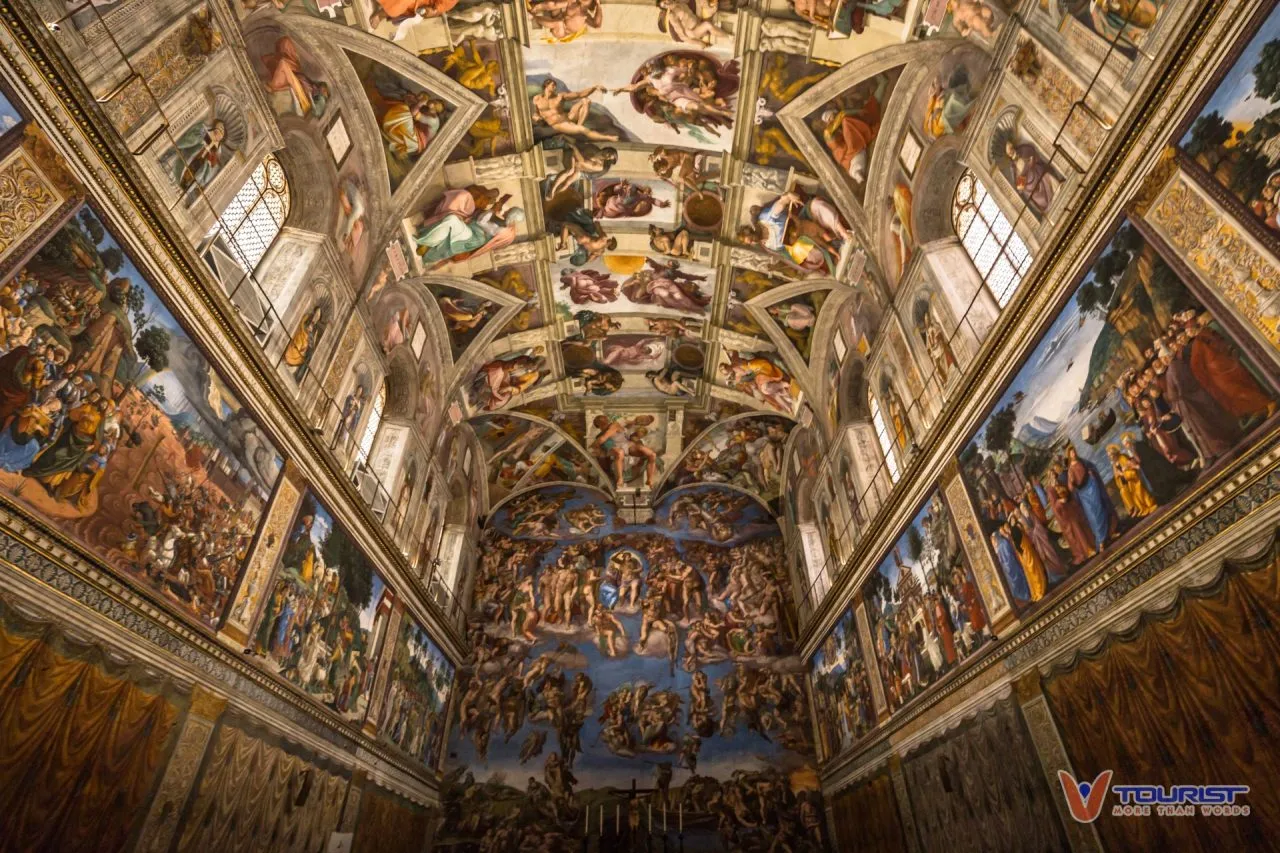Italy, the cradle of Renaissance culture, is a treasure trove of priceless art, where frescoes are not only artistic masterpieces but also witnesses of history. These works of art tell tales of the past, convey profound cultural values, and captivate viewers with their timeless beauty. From magnificent ceilings to grand walls, Italian frescoes offer an unforgettable journey through art.
But which are the most renowned frescoes that every art enthusiast should admire when visiting Italy? Join “Travel the World” as we explore these masterpieces, uncover their history, significance, and fascinating stories behind each piece, for a deeper understanding of the interplay between art, history, and Italian culture.
Sistine Chapel: Vatican’s Crown Jewel
The Sistine Chapel, located in the Apostolic Palace in Vatican City, is a must-visit destination for anyone passionate about art. Originally called Cappella Magna, the chapel was constructed during the papacy of Sixtus IV between 1473 and 1481 and is named after him. Throughout history, the Sistine Chapel has played a significant role in various religious and political events. Today, it remains the site of the Papal Conclave, where cardinals elect the new pope.
The Sistine Chapel is relatively small, with a total area of 520 square meters, in a rectangular shape and a height of 21 meters. From the outside, it resembles a fortress, but inside, it is lavishly decorated to showcase the grandeur and authority of the pope.

The most remarkable feature of the Sistine Chapel is its Renaissance frescoes covering the walls and ceiling. Legendary artists such as Botticelli, Perugino, Luca Signorelli, and notably Michelangelo left their indelible mark here.
Michelangelo and His Ceiling Masterpiece in the Sistine Chapel
All the frescoes on the Sistine Chapel’s ceiling are the work of Michelangelo, one of the greatest artists of all time. He dedicated four years, from 1508 to 1512, to completing this masterpiece.
The highlight of the ceiling frescoes is nine scenes from the Bible, occupying much of the chapel’s central area. These artworks depict significant events from the Book of Genesis, from the Creation of the World to the Life of Noah.
The overarching theme of the ceiling frescoes was the story of “Genesis” from the Hebrew Bible. The ceiling is composed of nine interconnected scenes, featuring more than 300 figures and nine central stories derived from the Revelations. The composition is divided into three groups: The Creation of Heaven and Earth by God, the creation of the first man and woman (Adam and Eve) and their fall, and the plea of humankind.

Michelangelo di Lodovico Buonarroti Simoni (1475–1564), known simply as Michelangelo, was a painter, sculptor, architect, poet, and engineer of the Italian Renaissance. He is celebrated as one of the most significant figures of the Renaissance era, with profound contributions to Western art and culture.
Each brushstroke of Michelangelo demonstrated reverence and devotion to the divine. He highlighted a pure, heavenly spirit, untouched by worldly troubles. The figures in the frescoes are often depicted naked, yet they evoke no sense of impropriety. Michelangelo portrayed them as strong, contemplative men and women immersed in thinking, reading, writing, debating, and listening to their inner voice.
Many assume such an extraordinary masterpiece must have been created by a team of esteemed artists. However, the truth is that this unique fresco was solely Michelangelo’s work. He spent four unwavering years refining and continuously painting the Sistine Chapel ceiling. Despite not being formally trained as a painter, he ultimately created one of the largest and most phenomenal frescoes in history.
“The Last Judgment”: A Controversial Masterpiece
After serving the Medici family for 25 years, Michelangelo returned to Vatican City and, between 1535 and 1541, painted “The Last Judgment” for Pope Clement VII and Pope Paul III. This fresco sparked much controversy and is brimming with deep symbolism.
“The Last Judgment” depicts humanity’s final reckoning, when Christ returns to Earth to judge the souls of mankind. The fresco includes over 300 characters, featuring Christ, the Virgin Mary, saints, angels, and the damned.
The fresco was controversial because Michelangelo depicted the figures naked, which was considered inappropriate for a church. Yet Michelangelo believed that he was showcasing the beauty and perfection of the human body.
Other Famous Frescoes in Italy
Besides the Sistine Chapel, Italy boasts countless other renowned frescoes scattered across cities and countryside. Some outstanding examples include:
- “The Last Supper” by Leonardo da Vinci at the Santa Maria delle Grazie convent in Milan: This painting illustrates Christ’s final meal with his apostles before his crucifixion.
- Giotto’s Fresco Cycle in the Scrovegni Chapel in Padua: This cycle features scenes from the lives of the Virgin Mary and Jesus Christ.
- Frescoes by Piero della Francesca in Arezzo: These frescoes recount the tale of the True Cross.
Tips for Exploring Italian Fresco Art
To fully immerse yourself in the world of Italian fresco art, consider these tips:
- Learn the history and significance of the frescoes beforehand. This will help you better understand what you’re seeing and appreciate the artistry.
- Reserve tickets in advance, especially for popular attractions like the Sistine Chapel. This prevents long waits and ensures entry.
- Bring binoculars to view the intricate details of the frescoes.
- Follow the rules of the sites you visit. For example, you might not be allowed to take photos or speak loudly.
- Take your time to admire the frescoes. Don’t rush—relax and soak in the beauty of the art.
Conclusion
Italy’s most famous frescoes are not only stunning works of art but also vital historical and cultural witnesses. They offer us valuable insights into the past and help us better understand Italian society and its people.
Plan your trip to discover Italy’s fresco art today, and experience the timeless beauty of these masterpieces! You won’t be disappointed.